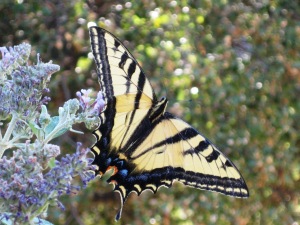Butterfly gardeners begin this way….they see a colorful butterfly in their garden and start paying attention. They want to see more so they wait and observe during the spring and summer. How can they see more kinds, they wonder. That’s how I began, I’m sure.
Once you begin observing, you notice more and more about these beautiful creatures. Everyone knows they drink nectar from flowers, but what kind of plants will attract them. Is it possible to plant the right kind of plants that would fill your garden with these ‘living leaves?’
Wild flowers, cultivated flowers (perennials and annuals) and even some shrubs are a fantastic start. Lilac bushes, blueberry bushes, grasses, abelia, butterfly weed, chrysanthemums, daises, purple coneflower, buddleias, black-eyed Susan, , goldenrods and verbena are all flowers and shrubs that will attract butterflies for your observation to your garden.
Butterflies in our Sierra Foothills include, Swallowtails, Buckeyes, Skippers and California Sisters and many more. If you’ve seen a butterfly in Central California that you’d like to identify, try Art Shaprio’s Butterfly Site., associated with UCDavis. Calphotos is another place where you can browse through many California butterflies.
Try these when designing a butterfly garden bed:
Tall
Buddleia davidii (Butterfly Bush)
Eupatorium purpureum (Joe-pye weed)
Medium-tall
Pennisetum setaceum (Purple Fountain Grass)
Asclepias tuberosa – Butterfly Weed
Kniphofia spp. – Red Hot Poker
Aster novae-angiae (New England aster)
Monarda (Bee Balm )
Asiatic Lily Rudbeckia hirta (Black-eyed Susan)
Echinacea purpurea (Purple Coneflower)
Liatris spicata (Blazing star)
Medium
Veronica spicata ‘Sunny Border Blue’
Coreopsis verticillata (Tickseed)
Gaillardia (Blanket flower)
Solidago canadensis (Goldenrod)
Agastache x ‘Ava’ (Hummingbird Mint)
Sedum Stonecrop ‘Autumn Joy’
Low
Scabiosa (Pin Cushion Flower)
Glandularia canadensis (Rose Verbena)
California foothill natives that attract butterflies
Arctostaphylos, Manzanita
Lonicera interrupta, Chaparral Honeysuckle
Lupinus albifrons, Silver Bush Lupine
Madia elegans, Elegant Tarweed
Muhlenbergia, rigens Deer Grass
Rudbeckia hirta, Black-eyed Susan
Wyethia elata, Hall’s Mule’s ears








6 comments